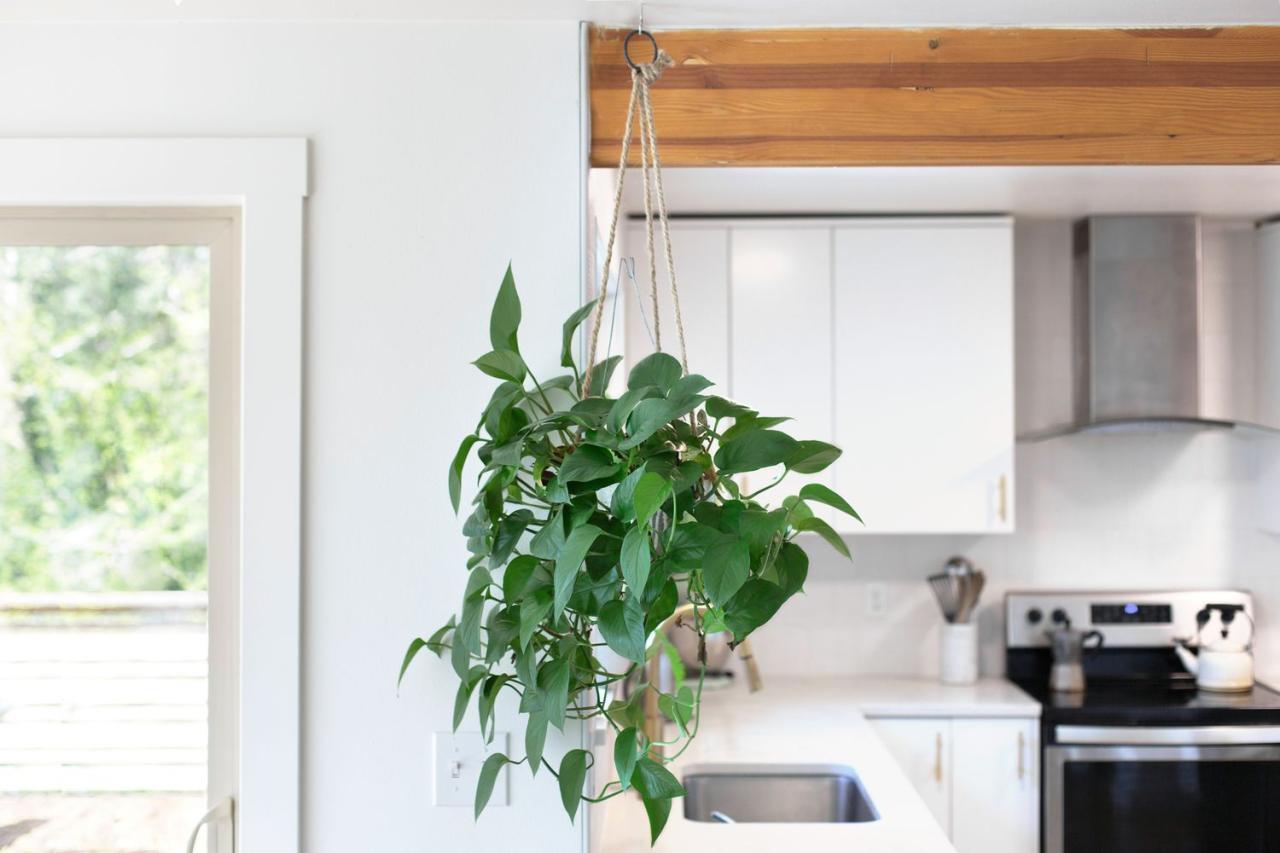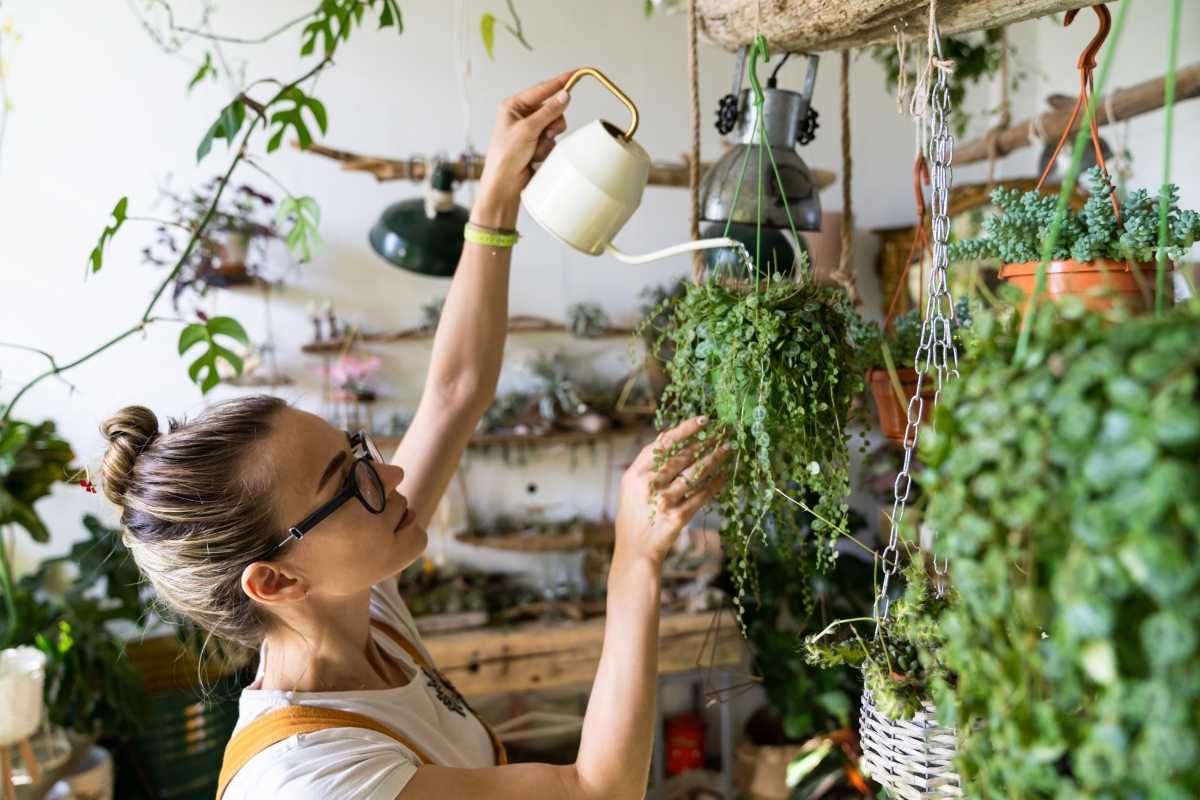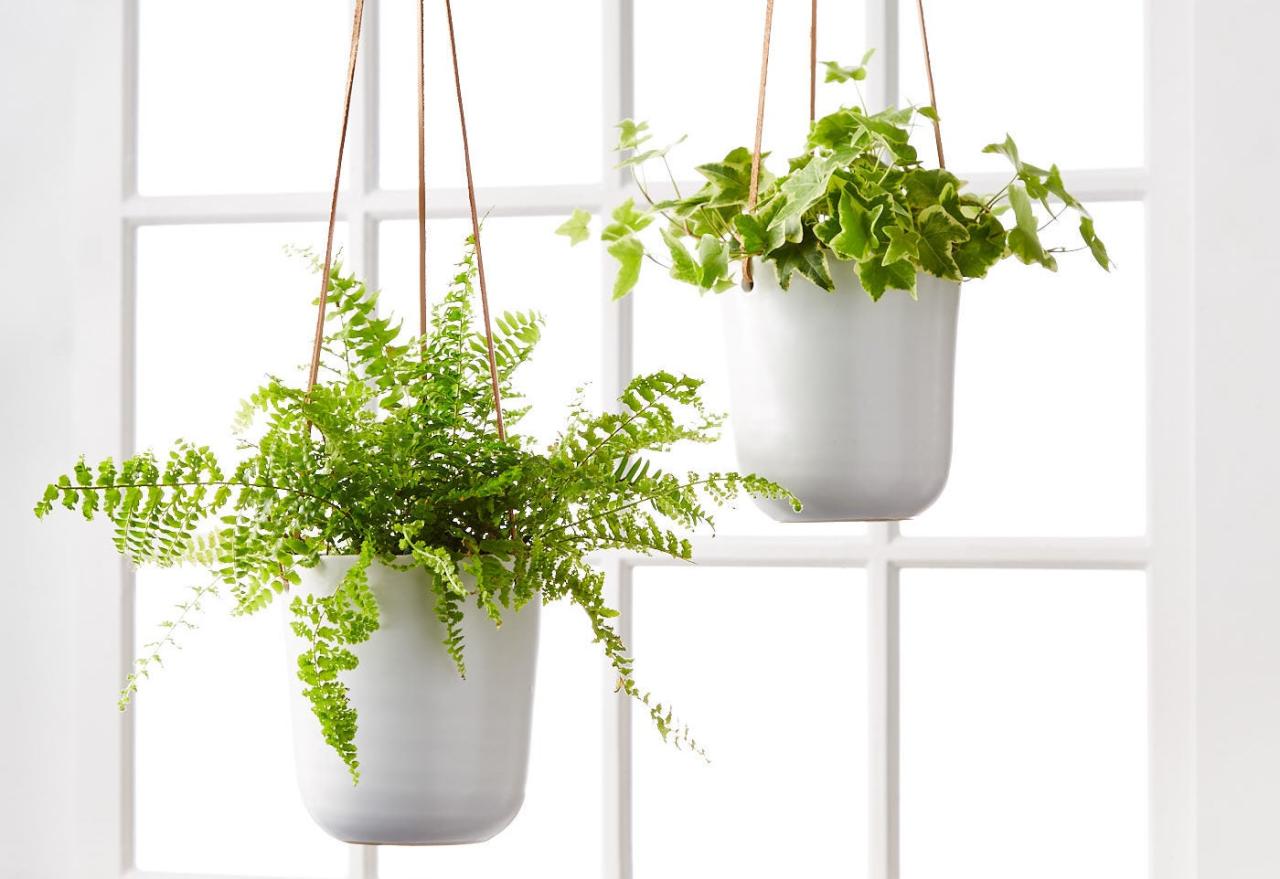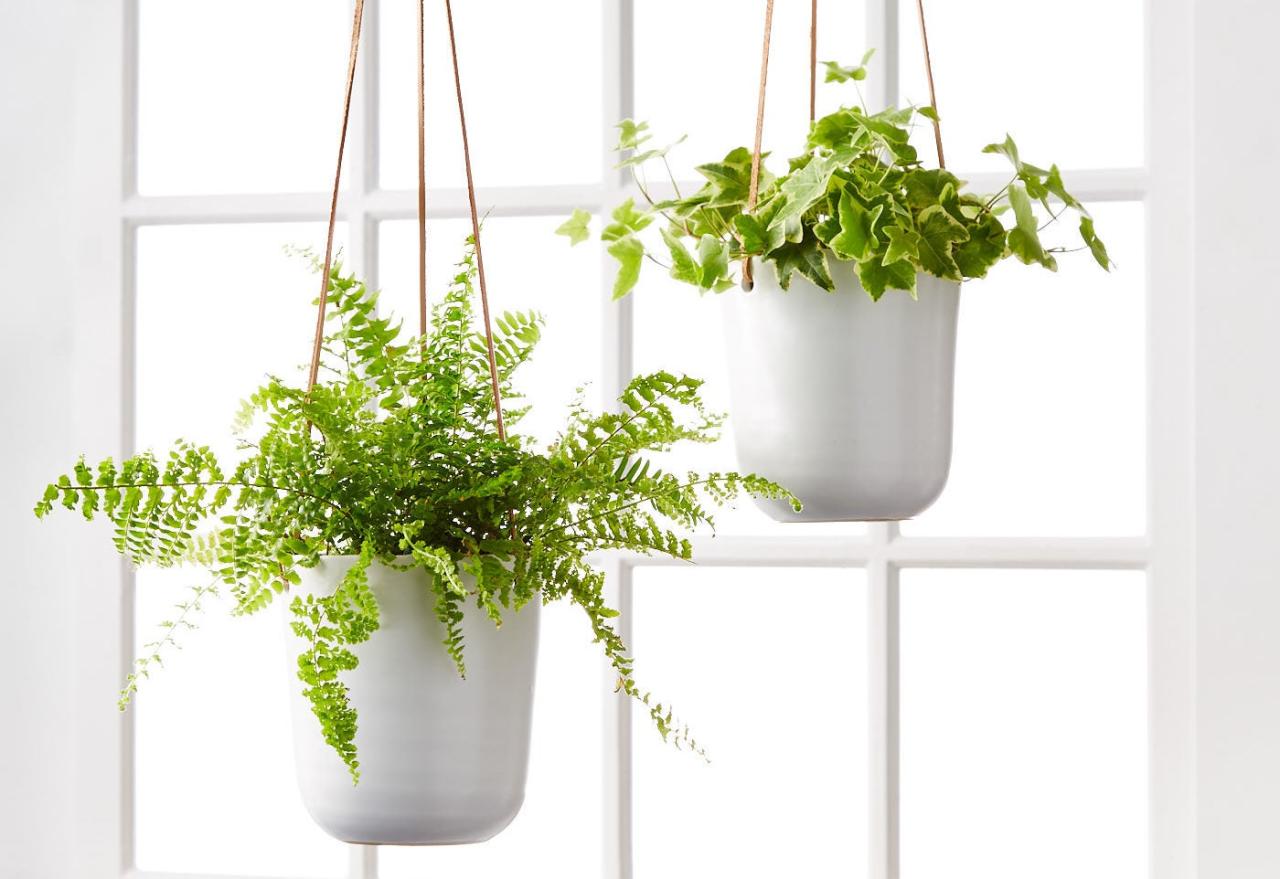How to Care for Hanging Plants Year-Round: Hanging plants add a touch of greenery and life to any space, whether it’s your home, office, or outdoor patio. But keeping these aerial beauties thriving year-round requires a bit of knowledge and care.
From selecting the right plant to understanding its specific needs, this guide will equip you with the essential tips and tricks to cultivate a flourishing hanging plant collection.
Whether you’re a seasoned plant parent or a novice gardener, this comprehensive guide will provide you with the knowledge and tools to ensure your hanging plants thrive throughout the year. We’ll cover everything from choosing the right plants to providing optimal conditions for growth, including light, water, humidity, and fertilization.
We’ll also address common problems like pests, diseases, and overwatering, so you can keep your hanging plants healthy and vibrant.
Choosing the Right Hanging Plants: How To Care For Hanging Plants Year-Round

Hanging plants add a touch of elegance and greenery to any space, whether indoors or outdoors. They’re a great way to bring life to a room, balcony, or patio. Choosing the right hanging plant for your environment is crucial for its health and longevity.
Factors to Consider When Selecting Hanging Plants
To ensure your hanging plants thrive, consider these factors:
- Light Requirements:Some plants prefer bright, indirect light, while others tolerate low light conditions. Knowing your home’s light levels will help you choose plants that will flourish.
- Water Needs:Different plants have varying water requirements. Some need frequent watering, while others prefer to dry out slightly between waterings.
- Growth Habits:Consider the size and shape of the plant at maturity. Some plants have trailing vines, while others have cascading foliage. Choose a plant that will complement your space.
- Temperature Tolerance:If you’re placing the plant outdoors, ensure it can tolerate the temperatures in your region.
Popular Hanging Plants for Indoor Environments
Indoor hanging plants can brighten up a room and improve air quality.
- Pothos (Epipremnum aureum):A popular choice due to its easy care and ability to tolerate low light. It features heart-shaped leaves that come in various colors, including green, yellow, and white.
- Spider Plant (Chlorophytum comosum):Known for its air-purifying qualities and ease of propagation. It produces spiderettes, or baby plants, on long stems.
- English Ivy (Hedera helix):This classic trailing plant thrives in bright, indirect light and can tolerate some shade. It features dark green leaves with distinctive lobes.
- String of Pearls (Senecio rowleyanus):A unique plant with trailing stems covered in round, bead-like leaves. It prefers bright, indirect light and moderate watering.
- Philodendron (Philodendron hederaceum):Another easy-to-care-for plant that comes in various colors and patterns. It tolerates low light and produces heart-shaped leaves.
Popular Hanging Plants for Outdoor Environments
Outdoor hanging plants can add beauty and vibrancy to patios, balconies, and gardens.
Caring for hanging plants year-round requires attention to their specific needs, such as providing adequate light and moisture. Just like the meticulous care required for Bonsai , hanging plants benefit from regular pruning to maintain their shape and encourage growth.
By understanding the principles of proper care, you can ensure your hanging plants thrive and bring beauty to your home throughout the seasons.
- Petunia (Petunia × hybrida):These flowering plants come in a wide range of colors and produce trumpet-shaped blooms. They prefer full sun and well-drained soil.
- Fuchsia (Fuchsia × hybrida):Known for their elegant, dangling flowers with vibrant colors. They thrive in partial shade and moist, well-drained soil.
- Trailing Geranium (Pelargonium peltatum):This plant features cascading stems with colorful flowers. It prefers full sun and well-drained soil.
- Begonia (Begonia):Some varieties of begonias have trailing growth habits. They prefer partial shade and moist, well-drained soil.
- Sweet Potato Vine (Ipomoea batatas):This plant features beautiful, heart-shaped leaves that come in various colors, including green, purple, and bronze. It prefers full sun and well-drained soil.
Benefits and Challenges of Different Hanging Plant Varieties
- Low-Maintenance Plants:Plants like pothos, spider plants, and philodendrons are known for their low-maintenance nature, making them ideal for busy individuals. They can tolerate some neglect and still thrive.
- High-Maintenance Plants:Plants like petunias, fuchsias, and begonias require more attention, including regular watering, fertilization, and deadheading. However, their beauty and vibrant blooms are worth the effort.
- Air-Purifying Plants:Spider plants and English ivy are known for their air-purifying properties, removing harmful toxins from the air. This makes them a healthy addition to any home.
- Fast-Growing Plants:Plants like pothos and spider plants are fast-growing, making them ideal for quickly filling a space with greenery. However, they may require frequent pruning to maintain their shape.
- Slow-Growing Plants:Some plants, like string of pearls, grow more slowly, requiring less frequent repotting and pruning. They offer a more gradual and controlled growth pattern.
Understanding Hanging Plant Care Essentials

To ensure your hanging plants thrive year-round, understanding their basic care needs is crucial. From providing adequate light to maintaining the right watering schedule, these essential practices contribute significantly to their overall health and growth.
Lighting Requirements for Hanging Plants
Light plays a vital role in the growth and development of hanging plants. It’s essential to provide the right amount of light for each specific plant species to promote healthy growth and vibrant foliage.
- Sunlight-loving hanging plants, like trailing succulents and string of pearls, require at least 6 hours of direct sunlight daily. These plants thrive in bright, sunny locations, ideally near a south-facing window.
- Shade-tolerant hanging plants, such as pothos and spider plants, prefer indirect sunlight or filtered light. These plants can tolerate lower light conditions but may not grow as vigorously as their sun-loving counterparts.
- Low-light hanging plants, like snake plants and ZZ plants, can tolerate very low light conditions. However, even these plants benefit from some indirect sunlight, especially during the winter months.
Watering Hanging Plants Effectively
Watering hanging plants appropriately is crucial for their well-being. Overwatering can lead to root rot, while underwatering can cause wilting and leaf drop.
- Check the soil moisture: Before watering, insert your finger about 2 inches into the soil. If the soil feels dry, it’s time to water.
- Water thoroughly: When watering, ensure the entire root ball is moistened. Avoid overwatering, as this can lead to root rot.
- Allow the soil to dry slightlybetween waterings to prevent overwatering.
Choosing the Right Potting Mix and Container
The right potting mix and container are essential for providing a healthy environment for your hanging plants.
- Potting mix: Choose a well-draining potting mix specifically designed for hanging plants. This type of mix will help prevent waterlogging and ensure proper aeration for the roots.
- Container: Opt for a container with drainage holes to prevent water from accumulating in the bottom. The size of the container should be appropriate for the plant’s size, allowing room for root growth. Terracotta pots are excellent for hanging plants as they allow excess water to evaporate, reducing the risk of root rot.
Ensuring Adequate Drainage
Proper drainage is crucial for preventing root rot and promoting healthy plant growth.
- Drainage holes: Ensure the container has drainage holes to allow excess water to escape.
- Drainage layer: Consider adding a layer of gravel or pebbles to the bottom of the container to improve drainage. This layer will help prevent the roots from sitting in water.
- Avoid overwatering: It’s crucial to avoid overwatering hanging plants, as this can lead to root rot. Water only when the soil is dry to the touch.
Providing Optimal Conditions for Growth
Hanging plants, with their cascading foliage, add a touch of elegance and life to any space. But these beauties thrive only when given the right conditions. One of the key factors in maintaining healthy hanging plants is ensuring they have the right amount of humidity.
Humidity and Hanging Plants
Hanging plants, especially those originating from tropical or humid environments, often struggle in drier indoor settings. Humidity plays a crucial role in their well-being, impacting everything from leaf health to growth rate. When the air is too dry, the plant’s leaves can become brittle, brown, and prone to pests.
Increasing Humidity Around Hanging Plants
There are several techniques you can use to boost humidity levels around your hanging plants:
- Pebble Trays:Place a shallow tray filled with pebbles and water beneath the plant’s pot. As the water evaporates, it increases humidity around the plant. Ensure the pot’s base is not submerged in water, as this can lead to root rot.
- Humidifiers:Using a cool-mist humidifier can significantly increase humidity in a room. Place the humidifier near your hanging plants, but avoid directing the mist directly at the foliage.
- Grouping Plants:Clustering plants together can create a micro-climate that traps moisture, increasing humidity in the immediate vicinity.
Fertilizing Hanging Plants, How to Care for Hanging Plants Year-Round
Regular fertilization is essential for hanging plants, as it provides the nutrients they need to grow strong and lush. The best time to fertilize is during the growing season, typically from spring to fall.
- Liquid Fertilizers:Diluted liquid fertilizers are easily absorbed by hanging plants and can be applied directly to the soil. Follow the manufacturer’s instructions for the appropriate dilution ratio.
- Slow-Release Granules:These granules provide a consistent supply of nutrients over a longer period. Apply them to the soil according to the product instructions.
Pruning Hanging Plants
Pruning is a crucial aspect of hanging plant care, as it helps maintain their shape, encourage bushier growth, and remove any dead or diseased foliage.
- Pinch Back Tips:Pinching back the growing tips of stems encourages the plant to branch out, creating a fuller, more dense appearance. This is especially beneficial for trailing plants like pothos and spider plants.
- Remove Dead or Diseased Foliage:Regularly inspect your hanging plants for dead or diseased leaves. Remove these promptly to prevent the spread of disease and maintain a healthy appearance.
- Shape and Trim:Depending on the type of hanging plant, you may need to trim and shape the foliage to maintain its desired form. This can be done by gently cutting back stems or leaves.
Troubleshooting Common Hanging Plant Issues

Even with proper care, hanging plants can encounter problems. Recognizing these issues early and taking corrective measures can help maintain their health and beauty.
Identifying Common Pests and Diseases
Pests and diseases can significantly impact the health of your hanging plants. Recognizing the signs early can help prevent widespread damage.
- Common Pests:
- Spider Mites:These tiny pests spin webs on the undersides of leaves and can cause yellowing and wilting.
- Mealybugs:These soft-bodied insects appear as white, cottony masses on stems and leaves, causing stunted growth.
- Aphids:These small, pear-shaped insects suck sap from plants, causing leaf distortion and yellowing.
- Scale Insects:These insects resemble small, brown bumps on stems and leaves, sucking sap and causing yellowing.
- Common Diseases:
- Powdery Mildew:This fungal disease appears as a white, powdery coating on leaves, hindering photosynthesis.
- Root Rot:This fungal disease occurs when soil is constantly wet, leading to root decay and wilting.
- Leaf Spot:Fungal or bacterial infections cause brown or black spots on leaves, potentially spreading to other plants.
Preventing and Treating Common Hanging Plant Problems
Taking proactive measures can help prevent pest and disease issues and ensure the health of your hanging plants.
- Regular Inspection:Regularly examine your plants for signs of pests or diseases.
- Proper Watering:Avoid overwatering, which can lead to root rot and fungal diseases.
- Good Air Circulation:Ensure adequate air circulation around your plants to prevent fungal growth.
- Pest Control:Use insecticidal soap or neem oil to control pests.
- Disease Treatment:Treat fungal diseases with fungicides or remove affected plant parts.
Recognizing Signs of Overwatering and Underwatering
Understanding the signs of overwatering and underwatering is crucial for maintaining the health of your hanging plants.
- Overwatering:
- Yellowing leaves
- Wilting stems
- Soggy soil
- Foul odor from the soil
- Underwatering:
- Dry, crispy leaves
- Wilting stems
- Dry soil
- Drooping foliage
Reviving a Struggling Hanging Plant
If your hanging plant shows signs of distress, there are steps you can take to revive it.
- Assess the Problem:Determine the cause of the problem, whether it’s overwatering, underwatering, pests, or disease.
- Adjust Watering:Adjust your watering routine based on the plant’s needs and soil moisture.
- Repotting:If the soil is compacted or the pot is too small, repot your plant into fresh soil and a larger container.
- Pruning:Remove any damaged or diseased leaves or stems to encourage new growth.
- Pest and Disease Treatment:Address any pest or disease issues with appropriate treatments.
- Provide Optimal Conditions:Ensure the plant receives adequate light, humidity, and temperature.
Creating Stunning Hanging Plant Displays
Transforming your indoor and outdoor spaces with hanging plants is an art form that involves careful planning and execution. By incorporating diverse plant varieties, creative containers, and strategic placement, you can craft breathtaking displays that enhance the ambiance and beauty of your surroundings.
Designing Hanging Plant Arrangements
Designing hanging plant arrangements involves considering the specific characteristics of your plants, the available space, and the overall aesthetic you wish to achieve. This includes choosing the right plants, selecting suitable containers, and determining the best locations for your hanging displays.
Space |
Plant Arrangement |
Description |
|---|---|---|
Indoor Living Room |
Combination of trailing and cascading plants |
Create a lush and inviting atmosphere with a mix of plants like pothos, spider plants, and philodendrons. |
Outdoor Patio |
Assortment of flowering and foliage plants |
Combine colorful blooms like petunias and geraniums with leafy greens like ferns and ivy for a vibrant display. |
Balcony |
Vertical garden with multiple hanging planters |
Maximize space by using a variety of hanging planters to create a lush green wall. |
Bedroom |
Simple and elegant arrangement with trailing succulents |
Create a serene and minimalist look with a few hanging succulents like string of pearls or burro’s tail. |
Materials and Tools for Creating Hanging Plant Displays
To create beautiful hanging plant displays, you’ll need a collection of materials and tools to ensure success. These tools will help you select the right plants, prepare the containers, and safely hang your plants.
- Hanging planters: Choose a variety of sizes and materials to suit your plants and aesthetic.
- Plant hooks: Select strong and durable hooks that can support the weight of your planters.
- Potting soil: Choose a high-quality potting mix specifically designed for hanging plants.
- Gardening gloves: Protect your hands while working with plants and soil.
- Watering can: Use a watering can with a long spout to reach the roots of your plants.
- Measuring tape: Determine the appropriate hanging height and distance for your plants.
- Scissors or pruning shears: Trim dead or overgrown foliage to maintain a healthy and aesthetically pleasing appearance.
Incorporating Hanging Plants into Home Decor
Hanging plants can transform your home into a lush and vibrant oasis. By strategically placing them in various areas, you can enhance the overall ambiance and create focal points that draw attention.
- Living Room: Hang plants near windows or above furniture to create a natural and inviting atmosphere.
- Kitchen: Incorporate hanging herbs or flowering plants to add a touch of freshness and fragrance.
- Bedroom: Create a serene and relaxing space with trailing plants like spider plants or pothos.
- Bathroom: Hang moisture-loving plants like ferns or peace lilies to add a touch of greenery and humidity.
Incorporating Hanging Plants into Gardens and Balconies
Hanging plants can add vertical dimension and visual interest to your garden or balcony. They are particularly useful for small spaces, as they allow you to maximize vertical space and create a sense of abundance.
- Garden: Use hanging baskets to add color and texture to pathways, fences, or trellises.
- Balcony: Create a lush and inviting space by hanging plants in various sizes and shapes.
- Patio: Use hanging planters to create a focal point or define different areas within your patio.
Visual Guide for Hanging Plants Safely and Effectively
Hanging plants safely and effectively is crucial for their well-being and the safety of your home or garden. This visual guide demonstrates the steps involved in creating a secure and aesthetically pleasing hanging plant display. Step 1: Selecting the Right Hanging Planter>Choose a planter that is appropriate for the size and weight of your plant.
Consider the material, style, and drainage capabilities of the planter.* Step 2: Preparing the Planter>Fill the planter with a high-quality potting mix specifically designed for hanging plants. Ensure proper drainage by adding a layer of gravel or pebbles at the bottom.* Step 3: Planting Your Plant>Carefully remove the plant from its original container and gently loosen the roots.
Place the plant in the center of the planter and fill in with potting mix, ensuring the roots are covered.* Step 4: Hanging the Planter>Use strong and durable hooks that can support the weight of the planter. Choose a location that provides adequate sunlight and ventilation for your plant.* Step 5: Watering and Maintaining Your Plant>Water your plant regularly, ensuring the soil is consistently moist but not soggy.
Monitor your plant for signs of pests or diseases and take appropriate measures to address any issues.*
Epilogue
By following these tips, you can create stunning hanging plant displays that will brighten up your space and bring a touch of nature indoors or out. Remember, caring for hanging plants is a rewarding experience that requires patience and dedication.
With the right knowledge and a little TLC, you can enjoy the beauty of these captivating plants year-round.
FAQs
What are some of the best hanging plants for beginners?
Some easy-to-care-for hanging plants for beginners include pothos, spider plants, and string of pearls. These plants are known for their resilience and ability to tolerate a range of conditions.
How often should I fertilize my hanging plants?
Fertilize your hanging plants every 2-4 weeks during the growing season (spring and summer) with a balanced liquid fertilizer diluted to half strength. Reduce fertilization during the winter months.
What should I do if my hanging plant starts to droop?
Drooping can be a sign of overwatering, underwatering, or lack of light. Check the soil moisture, adjust your watering schedule, and ensure the plant is receiving adequate light. If the problem persists, consider repotting the plant into fresh soil.

